Related Research Articles

Hornblende is a complex inosilicate series of minerals. It is not a recognized mineral in its own right, but the name is used as a general or field term, to refer to a dark amphibole. Hornblende minerals are common in igneous and metamorphic rocks.
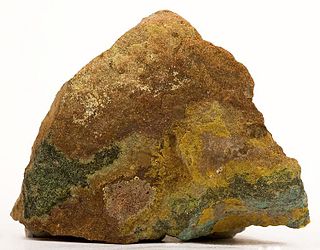
Zippeite is a hydrous potassium uranium sulfate mineral with formula: K4(UO2)6(SO4)3(OH)10·4(H2O). It forms yellow to reddish brown monoclinic-prismatic crystals with perfect cleavage. The typical form is as encrustations and pulverulent earthy masses. It forms as efflorescent encrustations in underground uranium mines. It has a Mohs hardness of 2 and a specific gravity of 3.66. It is strongly fluorescent yellow under ultraviolet light and is moderately radioactive.
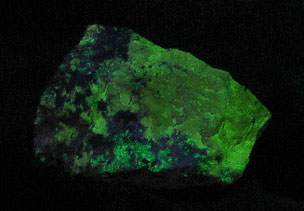
Esperite is a rare complex calcium lead zinc silicate (PbCa3Zn4(SiO4)4) related to beryllonite and trimerite that used to be called calcium larsenite. It was named in honor of Esper F. Larsen Jr. (1879–1961), petrologist of Harvard University.
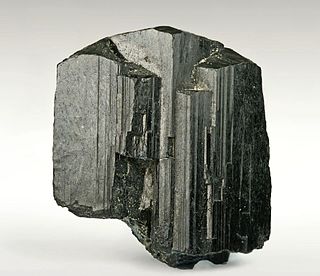
Arfvedsonite is a sodium amphibole mineral with composition: [Na][Na2][(Fe2+)4Fe3+][(OH)2|Si8O22]. It crystallizes in the monoclinic prismatic crystal system and typically occurs as greenish black to bluish grey fibrous to radiating or stellate prisms.

Aegirine is a member of the clinopyroxene group of inosilicate minerals. Aegirine is the sodium endmember of the aegirine-augite series. Aegirine has the chemical formula NaFeSi2O6 in which the iron is present as Fe3+. In the aegirine-augite series the sodium is variably replaced by calcium with iron(II) and magnesium replacing the iron(III) to balance the charge. Aluminium also substitutes for the iron(III). Acmite is a fibrous, green-colored variety.

Hausmannite is a complex oxide of manganese containing both di- and tri-valent manganese. The formula can be represented as Mn2+Mn3+2O4. It belongs to the spinel group and forms tetragonal crystals. Hausmannite is a brown to black metallic mineral with Mohs hardness of 5.5 and a specific gravity of 4.8.

Lithiophilite is a mineral containing the element lithium. It is lithium manganese(II) phosphate with chemical formula LiMnPO4. It occurs in pegmatites often associated with triphylite, the iron end member in a solid solution series. The mineral with intermediate composition is known as sicklerite and has the chemical formula Li(Mn,Fe)PO4). The name lithiophilite is derived from the Greek philos (φιλός) "friend," as lithiophilite is usually found with lithium.

Aenigmatite, also known as Cossyrite after Cossyra, the ancient name of Pantelleria, is a sodium, iron, titanium inosilicate mineral. The chemical formula is Na2Fe2+5TiSi6O20 and its structure consists of single tetrahedral chains with a repeat unit of four and complex side branches. It forms brown to black triclinic lamellar crystals. It has Mohs hardness of 5.5 to 6 and specific gravity of 3.74 to 3.85. Aenigmatite forms a solid-solution series with wilkinsonite, Na2Fe2+4Fe3+2Si6O20.
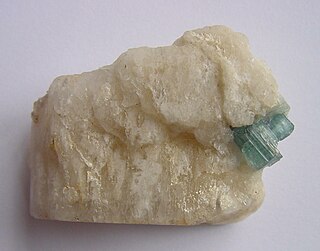
Beryllonite is a rare sodium beryllium phosphate mineral with formula NaBePO4. The tabular to prismatic monoclinic crystals vary from colorless to white or pale yellowish, and are transparent with a vitreous luster. Twinning is common and occurs in several forms. It exhibits perfect cleavage in one direction. The hardness is 5.5 to 6 and the specific gravity is 2.8. Refractive indices are nα = 1.552, nβ = 1.558 and nγ = 1.561. A few crystals have been cut and faceted, but, as the refractive index is no higher than that of quartz, they do not make very brilliant gemstones.

Clinozoisite is a complex calcium aluminium sorosilicate mineral with formula: Ca2Al3(Si2O7)(SiO4)O(OH). It forms a continuous solid solution series with epidote by substitution of iron(III) in the aluminium (m3 site) and is also called aluminium epidote.

Cronstedtite is a complex iron silicate mineral belonging to the serpentine group of minerals. Its chemical formula is Fe2+
2Fe3+
(Si,Fe3+
O
5)(OH)
4.
Geigerite is a mineral, a complex hydrous manganese arsenate with formula: Mn5(AsO3OH)2(AsO4)2·10H2O. It forms triclinic pinacoidal, vitreous, colorless to red to brown crystals. It has a Mohs hardness of 3 and a specific gravity of 3.05.

Sauconite is a complex phyllosilicate mineral of the smectite clay group, formula Na0.3Zn3(SiAl)4O10(OH)2·4H2O. It forms soft earthy bluish white to red-brown monoclinic crystals typically massive to micaceous in habit. It has a Mohs hardness of 1 to 2 and a specific gravity of 2.45. Optically it is biaxial positive with refractive index values of nα = 1.550 - 1.580, nβ = 1.590 - 1.620 and nγ = 1.590 - 1.620. It is found in vugs and seams in the oxidized zones of zinc and copper deposits. It occurs in association with hemimorphite, smithsonite, chrysocolla, coronadite and various iron oxides.
Zincobotryogen is a hydrous sulfate mineral with the chemical formula (Zn,Mg,Mn)Fe3+(SO4)2(OH)·7H2O. It forms bright orange red monoclinic prismatic crystals that exhibit a vitreous to greasy luster. Its specific gravity is 2.201 and it has a Mohs hardness of 2.5.
Albrechtschraufite (IMA symbol: Asf) is a very rare complex hydrated calcium and magnesium-bearing uranyl fluoride carbonate mineral with formula Ca4Mg(UO2)2(CO3)6F2·17H2O. Its molar weight is 1,428.98 g, color yellow-green, streak white, density 2.6 g/cm3, Mohs hardness 2-3, and luster is vitreous (glassy). It is named after Albrecht Schrauf (1837–1897), Professor of Mineralogy, University of Vienna. Its type locality is Jáchymov, Jáchymov District, Krušné Hory Mountains, Karlovy Vary Region, Bohemia, Czech Republic.
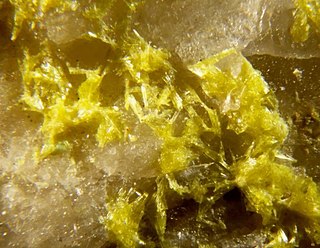
Althupite (IMA symbol: Ahp) is a rare aluminium thorium uranyl phosphate mineral with complex formula written as AlTh(UO2)7(PO4)4O2(OH)5·15H2O, from a granitic pegmatite. It is named after its composition (ALuminium, THorium, Uranium, and Phosphorus).

Boleite is a complex halide mineral with formula: KPb26Ag9Cu24(OH)48Cl62. It was first described in 1891 as an oxychloride mineral. It is an isometric mineral which forms in deep-blue cubes. There are numerous minerals related to boleite, such as pseudoboleite, cumengite, and diaboleite, and these all have the same complex crystal structure. They all contain bright-blue cubic forms and are formed in altered zones of lead and copper deposits, produced during the reaction of chloride bearing solutions with primary sulfide minerals.

Beraunite is an iron phosphate mineral. It was first described by August Breithaupt for an occurrence in Beraun currently in the Czech Republic. Beraunite occurs as a secondary mineral in iron ore deposits, and as an alteration product of primary phosphate minerals in granite pegmatites.
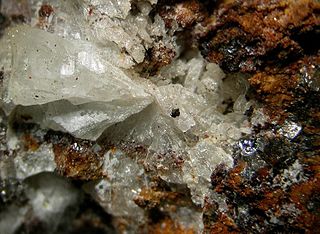
Fluellite is a mineral with the chemical formula Al2(PO4)F2(OH)•7H2O. The name is from its chemical composition, being a fluate of alumine (French).
Kochite is a rare silicate mineral with chemical formula of (Na,Ca)3Ca2(Mn,Ca)ZrTi[(F,O)4(Si2O7)2] or double that. Kochite is a member of the rosenbuschite group.
References
- ↑ Warr, L.N. (2021). "IMA–CNMNC approved mineral symbols". Mineralogical Magazine. 85 (3): 291–320. Bibcode:2021MinM...85..291W. doi:10.1180/mgm.2021.43. S2CID 235729616.
- ↑ Mindat.org
- 1 2 Webmineral data
- ↑ Handbook of Mineralogy